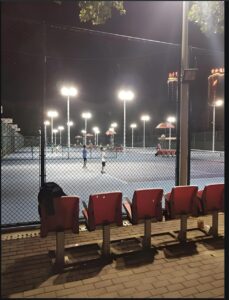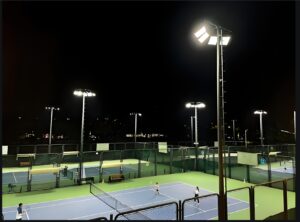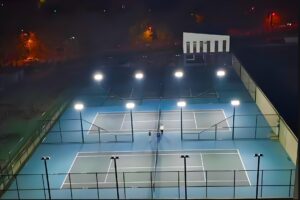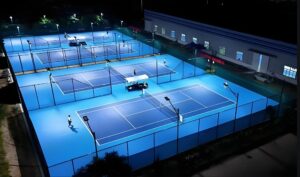- Design of Fixtures: LEDs designed for sports venues, including tennis courts, typically incorporate shields or baffles around the fixtures. These prevent light from scattering and ensure that the illumination stays concentrated on the court, where it is most needed.
d. Low-Glare Fixtures for Better Visual Comfort
The design of low-glare LED fixtures allows light to be emitted in a manner that reduces the intensity of direct light entering the eyes. This is particularly important in tennis, where players are often looking up to track the ball against the background of bright lights.
- Quality of Light: LEDs offer high-quality light that is evenly diffused, which reduces harsh light spots and glare effects common with traditional lamps. High-quality LEDs can achieve high light output levels without creating the harsh, intense glare often associated with older lighting technologies.
3. The Role of LED Color Temperature in Glare Control
The color temperature of LED lights also plays an important role in glare control. Tennis venues like Wimbledon need to use lights that create natural-looking illumination that enhances the visibility of the ball while avoiding discomfort due to glare.
- Adjustable Color Temperatures: LEDs allow for precise control over color temperature, which is the hue or tone of the light emitted. By adjusting the color temperature to match natural daylight (typically around 5000K–6000K), LED lights can reduce visual strain and enhance contrast. This results in better visibility of the tennis ball, reducing the chance of glare or washout.
- Warmer Tones for Comfort: During evening matches or post-match interviews, lighting can be adjusted to a warmer color temperature (around 3000K–4000K) to create a more comfortable atmosphere without sacrificing visibility. Warmer light levels also reduce eye strain, ensuring that players and viewers are not subjected to the harsh brightness that often accompanies cooler lights.

4. Controlling Spill Light to Minimize Glare for Spectators
In addition to player comfort, it is essential to manage glare for the audience—both in the stadium and for those watching at home. The bright lights of a tennis court can often spill into the stands or onto the broadcast cameras, causing discomfort for spectators or creating unwanted reflections in the TV feed.
- Spill Light Management: LED systems help control spill light by using advanced optics that direct the light precisely onto the court. This reduces the chance of light spilling over into unwanted areas, ensuring that spectators enjoy a glare-free viewing experience.
- Reducing Light Reflection: LED fixtures also help reduce light reflection off the court’s surface. Traditional lighting systems may reflect off the hard surfaces of the court, creating uncomfortable glare. LED systems are designed to emit light in a more controlled manner, reducing this reflective glare.
5. Advanced LED Drivers for Flicker-Free Lighting
One of the underlying causes of glare in sports lighting systems is flicker—rapid fluctuations in light intensity. Flicker can lead to visual discomfort, especially for high-speed sports like tennis, where the ball is constantly in motion. LED drivers are designed to provide flicker-free lighting, ensuring a steady, consistent light output that reduces glare and enhances the quality of both the live experience and the broadcast feed.
- High-Frequency Drivers: Advanced LED drivers can regulate the flow of power to LEDs, ensuring that the lights operate at a consistent frequency, eliminating flicker. This is essential in professional tennis, where the smooth motion of the ball needs to be captured in high-definition broadcasts, free from any flickering effects.
6. Player Performance and Glare-Free Lighting
Players depend on clear, unobstructed vision to track the ball, anticipate movements, and respond quickly. Glare, whether from direct lighting or reflections, can hinder a player’s ability to perform at their best. By using LED systems, tennis venues can create an environment where players can focus entirely on the game without the distraction of glare.
Benefits for Player Focus and Performance:
- Consistent Light Intensity: LEDs provide a stable, glare-free light source, ensuring that players do not experience sudden shifts in light intensity or uncomfortable flashes of brightness.
- Reduced Visual Fatigue: Proper glare control reduces visual discomfort, allowing players to stay focused throughout long matches without straining their eyes.
Glare presents a unique challenge for lighting systems in tennis, affecting both player performance and the spectator experience. However, LED lighting technology has proven to be a highly effective solution to this problem. With directional lighting, adjustable optics, low-glare fixtures, and precise control over color temperature, LED systems can minimize glare, ensuring that the focus remains on the game itself. Additionally, by providing flicker-free lighting and reducing spill light, LED systems improve visual comfort for players, spectators, and broadcasters, ensuring an optimal experience for everyone involved.
The impact of reduced shadows on player performance and viewer experience
In sports like tennis, where speed and precision are paramount, the quality of lighting plays a crucial role in ensuring the best possible performance. Shadows, whether on the court or in the surrounding environment, can have a significant impact on both the player’s ability to track the ball and the spectator’s viewing experience. Reduced shadows in the lighting design not only enhance player focus and accuracy but also create a more immersive and enjoyable atmosphere for fans. Here’s how reducing shadows improves both player performance and the viewer experience in tennis.
1. Impact of Shadows on Player Performance
a. Visual Distractions and Loss of Focus
In tennis, the ball is moving at high speeds, and players must maintain constant awareness of its trajectory to anticipate and react quickly. Shadows on the court can significantly hinder a player’s ability to track the ball properly, especially in situations where the ball crosses from a brightly lit area into a shadowed one.
- Flickering or Changing Light: As a player moves around the court, different areas might be illuminated differently, causing them to experience fluctuating lighting conditions. This could result in glare or contrast changes between lit and shadowed areas, leading to a momentary loss of visual clarity and focus.
- Difficulty in Ball Tracking: A shadow cast over the ball, especially when the ball is in mid-air or nearing the ground, can make it hard for players to judge the ball’s speed, spin, and position. Shadows might distort the way the ball appears, leading to incorrect anticipation of its movement. This is particularly important when trying to gauge a high-speed serve or a deep baseline shot.

b. Unpredictable Court Surfaces
In tennis, the surface of the court—whether grass, clay, or hard court—also plays a role in how the ball behaves. Inconsistent lighting due to shadows can create a false impression of the ball’s movement across the court, especially when players are transitioning between areas of light and dark.
- Surface Reflection: A poorly lit area or inconsistent lighting can create shadows on the court surface itself, which distorts the ball’s bounce and makes it more difficult for players to predict. Grass courts, like those used at Wimbledon, are particularly prone to this challenge, where shadows can obscure small irregularities in the playing surface that would otherwise be visible in well-lit conditions.
c. Reduced Accuracy in Quick Reflexes
In professional tennis, a player’s reaction time and quick reflexes are essential, especially during fast-paced rallies. Shadows can create a delay in a player’s visual perception, causing them to react too late to the ball.
- Delayed Response: If a player is moving between well-lit and shadowed areas of the court, they may experience a lag in processing the ball’s movement due to the changing lighting conditions. This delay can affect their timing, leading to a missed shot or an inaccurate return.
2. How Reduced Shadows Improve Player Performance
a. Consistent Visibility Across the Court
Reduced shadows in LED lighting systems ensure consistent illumination across the entire court. This consistent lighting helps maintain an even level of brightness across the playing surface, allowing players to focus entirely on the game without being distracted by changes in light.
- Uniform Illumination: With proper lighting design, players will experience even light distribution, ensuring that they can see the ball clearly no matter where it is on the court. This consistency helps them track the ball’s movement accurately, without having to adjust their focus between light and dark areas.
b. Better Anticipation of Ball Movement
A key aspect of successful tennis play is being able to anticipate the ball’s path. With reduced shadows, players can more easily judge the trajectory of the ball and the way it will interact with the court surface.
- Clearer Ball Tracking: LED systems with uniform brightness across the court ensure that the ball remains visible at all times, even when it is in the air or bouncing on the surface. This allows players to make quicker and more accurate decisions, whether they are attempting a slice return or reacting to a fast serve.

c. Enhanced Visual Comfort for Long Matches
Professional tennis matches can last for hours, and visual fatigue can set in if players are constantly adjusting to changing light conditions. Reduced shadows help minimize eye strain, keeping the player’s vision sharp throughout the match. With consistent, uniform lighting, players can maintain a high level of concentration and focus over long periods of time.
3. Impact of Shadows on Viewer Experience
a. Discomfort and Distraction for Spectators
For the audience, both in the stadium and watching from home, the presence of shadows can create a distorted viewing experience. Just like players, spectators need clear and consistent lighting to properly see the action on the court. Shadows in the broadcast or stadium can lead to discomfort, causing viewers to miss key moments of the match.
- Inconsistent Lighting for Broadcasts: For televised tennis matches, shadows can interfere with the quality of the broadcast feed. If certain areas of the court are shadowed, the visual clarity of the ball and players may be diminished, leading to a less engaging viewing experience for the audience. This is particularly detrimental for high-speed matches where every shot and ball movement is critical.
b. Aesthetic Impact on the Match
In addition to affecting the clarity of the game, shadows can alter the overall aesthetic appeal of the match. Sports fans watching tennis expect to see a well-lit, dynamic court where every detail is visible. Unwanted shadows can make the court appear dull or disjointed, detracting from the enjoyment of the match.
- Consistent Court Appearance: Reduced shadows help maintain a uniform lighting environment, providing a clean, consistent look throughout the match. This improves the visual aesthetics of the event, ensuring that the viewers’ focus remains on the game and not the lighting inconsistencies.
4. How Reduced Shadows Improve Viewer Experience
a. Clearer, More Detailed Visuals for Spectators
In professional tennis, where every point can be critical, spectators need to see the game clearly and without distraction. With reduced shadows, viewers can enjoy the match in high detail, able to see the ball and the players’ movements without interference from changing light conditions.
- Enhanced Visibility for Televised Matches: On TV, consistent lighting improves the clarity of the broadcast feed, ensuring that the ball’s movement and the players’ actions are visible from every angle. This helps the audience follow the match more easily, particularly during fast-paced exchanges.
b. Immersive Experience for Fans in the Stadium
For fans in the stadium, reduced shadows contribute to a more immersive and comfortable viewing experience. With even lighting throughout the stadium, there is no visual discomfort from glare or shadowed areas. Fans can fully enjoy the excitement of the match, whether they are watching a player’s serve or a fast baseline rally.
- Comfortable Viewing: Reducing shadows ensures that spectators in all areas of the stadium, not just those in prime seating locations, can enjoy the match with the same level of visual clarity.
(To Be Continued)



